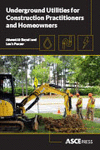Front Matter
Publication: Underground Utilities for Construction Practitioners and Homeowners
Contents
Preface vii
Chapter 1: Subsurface Utility Damage Prevention 1
Introduction 1
One-Call Process 2
Evolution of Damage Prevention 3
Damage Prevention Acts 4
Definition of Key Terms 5
Causes and Trends of Damages 9
Affected Services per Type of Employer 13
No Locate Request 13
The Cost of Damages 14
References 16
Appendix A: State Law Variations 17
Chapter 2: One-Call Centers 21
Introduction 21
Damage Prevention Act 22
Act Enforcement and Dispute Resolutions 23
Educational Outreach 24
Subsurface Utility Engineering—CI/ASCE 38-02 25
Case Study—North Carolina One Call Center (NC 811) 27
References 30
Chapter 3: Designers’ and Contractors’ Duties 33
Introduction 33
Design Phase 34
Construction Phase 35
Desirable Excavator Actions 35
Safe Excavation Process 38
Undesirable Excavator Actions 41
Homeowners’ Responsibilities 43
References 46
Appendix A: Locate Request Example 47
Appendix B: Excavators’ Duties—Selected Law Languages 48
Chapter 4: Utility Owners’ and Locators’ Duties 53
Introduction 53
Desirable Actions 54
Undesirable Actions 61
Utility Owners’ Actions—Case Studies 63
References 64
Chapter 5: Claim Resolution and Damage Investigation 67
Introduction 67
Federal Oversight 67
Variety of Enforcement Models 71
Damage Investigation 75
References 80
Appendix A: Incident Investigation Report 81
Appendix B: The Key Findings of the Durham Gas Explosion 85
Appendix C: Damage Investigation Sample 90
Index 95
About the Authors 99
Preface
The 2017 infrastructure report card created by ASCE was designed to evaluate the current state of America’s essential services such as energy, rail, bridges, and water. ASCE produces a letter grade, much like those in our children’s report cards. Sadly, the grade of our nation’s infrastructure was a disappointing D+. One of the key recommendations was the replacement of aging facilities. While the 2021 report has shown improvement to a grade of C+, recommendations to replace aging infrastructure remain a high priority. Accommodating the work to make this happen will mean increased excavation activity. The subject of this book is how to protect the existing infrastructure while working around it or replacing it.
Excavation in the United States happens thousands of times every day. Some of this work, as indicated, is done to repair damaged facilities. However, most of the work is done to install new facilities by professional contractors. In addition to the brand-new infrastructure being placed daily, infrastructure is placed at risk by excavation activities that are not associated with utilities. Those affected include homeowners, nurseries, fence companies, agriculture, and many other types of digging and demolition. This book explores the evolution of the protection of millions of miles of underground utilities in the United States from every kind of activity that disturbs the Earth.
While it is impossible to include every nuance of the laws in each state, the authors provide an overview of the process that is generally followed across the United States. For more specific details about individual state laws or enforcement practices, links are provided in an appendix, as well as in a summary matrix, providing a current snapshot of key differences such as tolerance zones, exemptions, and wait times for excavators.
If terms such as “tolerance zone” are not clear to readers now, they will be by the time they finish reading this book. It can be read cover to cover or used as a reference when looking into one’s unique situation.
A key caveat is that this book does not answer questions about the legality of any specific issue being experienced by the reader. The purpose is to make the full process understood and to provide insight into how the various laws are enforced. It should also be understood that laws are constantly changing, so this book represents a snapshot of the industry as of 2020.
As discussed, the safety and protection of assets are a shared responsibility. We hope that this book helps to reveal the role that all stakeholders in the process contribute to the reduction of injuries and damage to property.
Information & Authors
Information
Published In

Underground Utilities for Construction Practitioners and Homeowners
Pages: i - viii
ISBN (Print): 978-0-7844-1581-8
ISBN (Online): 978-0-7844-8357-2
Copyright
© 2021 American Society of Civil Engineers.
History
Published online: Sep 1, 2021
Published in print: Sep 9, 2021
Authors
Metrics & Citations
Metrics
Citations
Download citation
If you have the appropriate software installed, you can download article citation data to the citation manager of your choice. Simply select your manager software from the list below and click Download.